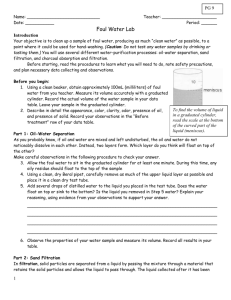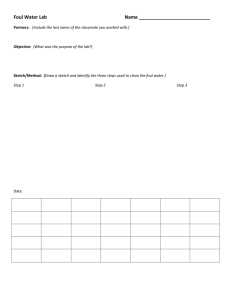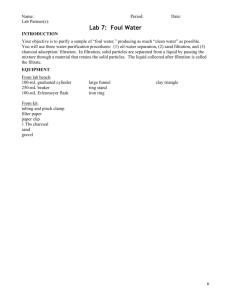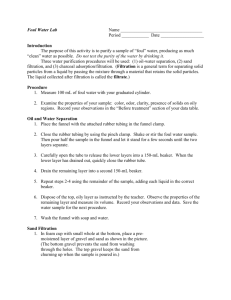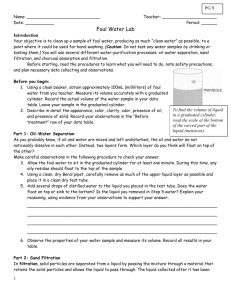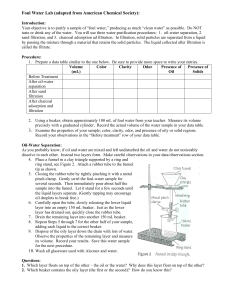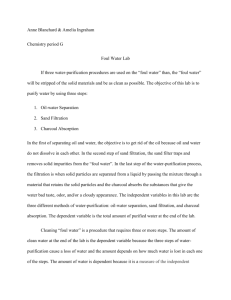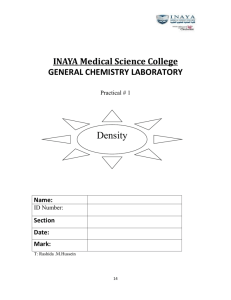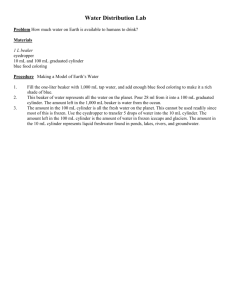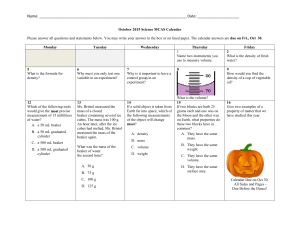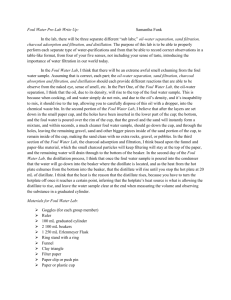Arnoldi / Keddie
advertisement
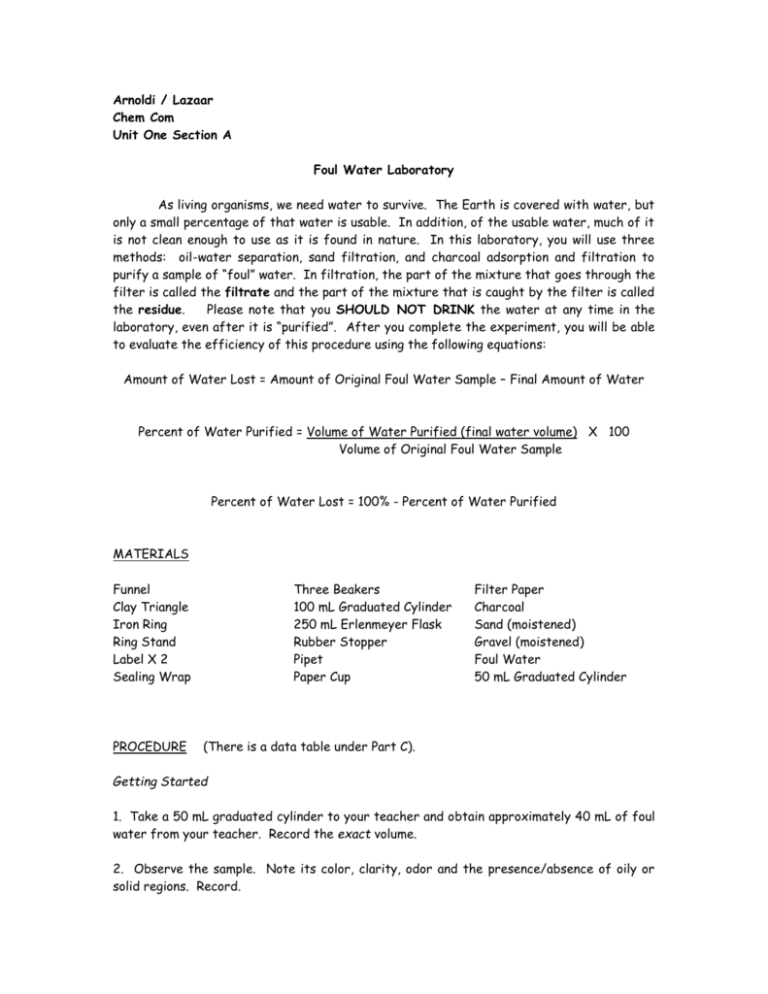
Arnoldi / Lazaar Chem Com Unit One Section A Foul Water Laboratory As living organisms, we need water to survive. The Earth is covered with water, but only a small percentage of that water is usable. In addition, of the usable water, much of it is not clean enough to use as it is found in nature. In this laboratory, you will use three methods: oil-water separation, sand filtration, and charcoal adsorption and filtration to purify a sample of “foul” water. In filtration, the part of the mixture that goes through the filter is called the filtrate and the part of the mixture that is caught by the filter is called the residue. Please note that you SHOULD NOT DRINK the water at any time in the laboratory, even after it is “purified”. After you complete the experiment, you will be able to evaluate the efficiency of this procedure using the following equations: Amount of Water Lost = Amount of Original Foul Water Sample – Final Amount of Water Percent of Water Purified = Volume of Water Purified (final water volume) X 100 Volume of Original Foul Water Sample Percent of Water Lost = 100% - Percent of Water Purified MATERIALS Funnel Clay Triangle Iron Ring Ring Stand Label X 2 Sealing Wrap PROCEDURE Three Beakers 100 mL Graduated Cylinder 250 mL Erlenmeyer Flask Rubber Stopper Pipet Paper Cup Filter Paper Charcoal Sand (moistened) Gravel (moistened) Foul Water 50 mL Graduated Cylinder (There is a data table under Part C). Getting Started 1. Take a 50 mL graduated cylinder to your teacher and obtain approximately 40 mL of foul water from your teacher. Record the exact volume. 2. Observe the sample. Note its color, clarity, odor and the presence/absence of oily or solid regions. Record. Part A: Oil-Water Separation 1. Let the contents of your foul water sample settle. Then, carefully use a pipet to remove the top layer from the 50 mL graduated cylinder. Squeeze the contents of the pipet into a 100 mL beaker. Repeat the removal as needed. 2. When you are finished removing the top layer from the 50 mL graduated cylinders, observe the color, clarity, odor and the presence/absence of oily/solid regions of the remaining water sample. Measure its volume (using the 50 mL graduated cylinder). Record. 3. This sample needs to be saved for part B. Set it aside. 4. Dispose of the oily layer in the large beaker set aside by your teacher for oil collection. Wash your beaker with soap and water. 5. Continue to part B. Part B: Sand Filtration 1. Using a straightened paper clip, poke 8 – 10 SMALL holes from the inside out in the bottom of a Styrofoam cup. In the cup, place a layer of gravel 1 cm thick, then a layer of sand 2 cm thick, then a second layer of gravel 1 cm thick. Be sure both the gravel and sand are pre-moistened!!! (Your teacher should have done this). 2. Place the cup in the iron ring as shown by your teacher. Place a beaker below the cup. Then, gently pour the liquid sample to be filtered into the cup. While the liquid is filtering, clean your 50 mL graduated cylinder with soap and water. 3. After the cup has completely drained, (you can tap on the sides of the cup to verify) dispose of the used sand and gravel cup in the trash. Do not put it in the sink! Rinse and keep the cup. 4. Once again, observe the properties of the filtered water sample and record. Using the 100 mL graduated cylinder, measure the exact volume of the water and record. 5. Place your remaining water sample in a 50 mL beaker. Seal. Label with your name and period. Put the beaker in a safe location as directed by your teacher. 6. Thoroughly clean your lab area – be sure to use soap and water to remove any oily residue in the equipment used. Part C: Charcoal Adsorption/Filtration 1. Set-up the filtering apparatus as shown by the teacher. (This includes: ring stand, iron ring, clay triangle, funnel, and filter paper – moistened). 2. Place a 250 mL beaker under the funnel. Make sure the funnel extends slightly into the beaker. 3. Place a small scoopula of charcoal into the Erlenmeyer flask. 4. Place the water sample into the flask. Close with a rubber stopper. Shake vigorously for a few seconds. 5. Pour the liquid into the filtering apparatus. Do not overflow! If the filtrate is clear, you are finished. If the filtrate has charcoal particles in it, re-filter with a new piece of filter paper and a clean beaker. You may need to filter several times. 6. Record the final properties and volume of you sample of water. 7. Place the “purified” water in a test tube, stopper it, label it with your name and period, and place it as directed by your teacher. 8. Dispose of the used charcoal as instructed by your teacher. 9. Clean all remaining glassware with soap and water. Clean your laboratory station. Wash your hands. DATA STEP Before Treatment After Part A After Part B After Part C VOLUME (mL) COLOR CLARITY ODOR PRESENCE OF OIL PRESENCE OF SOLIDS Arnoldi / Lazaar Chem Com Unit One Sections A&B Foul Water Laboratory Write-up DATA Fill in the data table below. (From Lab) STEP VOLUME COLOR CLARITY (mL) ODOR PRESENCE OF OIL PRESENCE OF SOLIDS Before Treatment After Oil/Water Separation After Sand Filtration After Charcoal Adsorption and Filtration Fill in the data table below (From Demo). DEMO Blinkee Tyndall Effect Distilled Water Foul Water “Purified Water” ANALYSIS 1. Determine the amount of water lost in the purifying process. (Show all work!) 2. Determine the percent of “pure” water recovered. (Show all work!) 3. Determine the percent of water lost in the purifying process. (Show all work!) 4. Error Analysis: (What might you have done to decrease the percent of pure water recovered? How could you fix this if you repeated the laboratory?) CONCLUSION 1. Is your “purified” water “pure” water? Explain. 2. How might you compare the quality of your water sample with that of other laboratory groups? 3. In the real world, it is often said that “time is money”. If you spent twice as much time in purifying your sample, would that extra investment in time “pay-off” in higher-quality water? What if you spent 10X as much time? 4. Municipal water-treatment plants do not use distillation to purify the water. Why?
